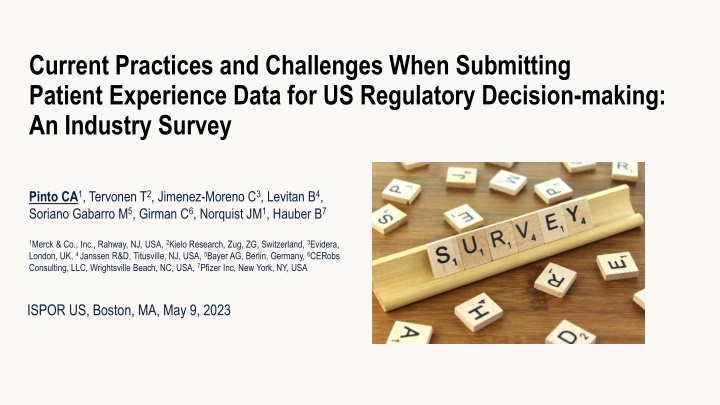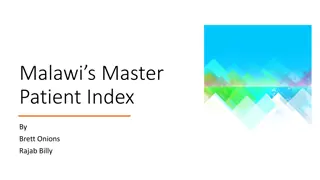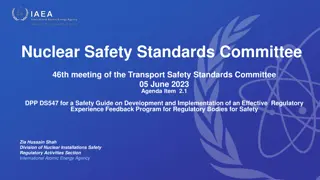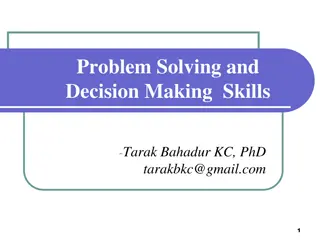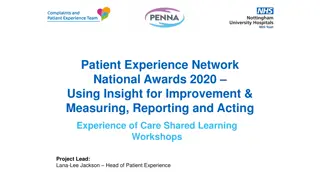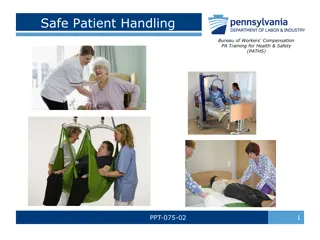Challenges and Practices in Patient Experience Data Submission for US Regulatory Decision-making
The study explores the current practices and challenges faced by industries when submitting patient experience data for US regulatory decision-making. It aims to expand on previous discussions and assess the importance of efforts to enhance the use of patient experience data in regulatory processes. Key areas of focus include collection, submission, and use of patient experience data, as well as obstacles encountered in the process.
Download Presentation

Please find below an Image/Link to download the presentation.
The content on the website is provided AS IS for your information and personal use only. It may not be sold, licensed, or shared on other websites without obtaining consent from the author.If you encounter any issues during the download, it is possible that the publisher has removed the file from their server.
You are allowed to download the files provided on this website for personal or commercial use, subject to the condition that they are used lawfully. All files are the property of their respective owners.
The content on the website is provided AS IS for your information and personal use only. It may not be sold, licensed, or shared on other websites without obtaining consent from the author.
E N D
Presentation Transcript
Current Practices and Challenges When Submitting Patient Experience Data for US Regulatory Decision-making: An Industry Survey Pinto CA1, Tervonen T2, Jimenez-Moreno C3, Levitan B4, Soriano Gabarro M5, Girman C6, Norquist JM1, Hauber B7 1Merck & Co., Inc., Rahway, NJ, USA,2Kielo Research, Zug, ZG, Switzerland,3Evidera, London, UK,4 Janssen R&D, Titusville, NJ, USA,5Bayer AG, Berlin, Germany,6CERobs Consulting, LLC, Wrightsville Beach, NC, USA,7Pfizer Inc, New York, NY, USA ISPOR US, Boston, MA, May 9, 2023
Conflict of Interest Dr. Pinto works for Merck Sharp & Dohme LLC, a subsidiary of Merck & Co., Inc., Rahway, NJ, USA, with stock ownership of Merck & Co., Inc., Rahway, NJ, USA The views and opinions expressed are those of the authors and do not necessarily reflect the views or positions of their employer 2
Acknowledgements This project was initiated by members of the International Society for Pharmacoepidemiology (ISPE) Real-world Evidence (RWE) and Regulatory Decision-making Working Group1to help advance a patient focused drug development related project. The research team included other subject matter experts in patient-focussed drug development. 1 Part of the ISPE Real-world Evidence Task Force 3
Introduction and Study Aim The 21st Century Cures Act required transparency and accountability for patient experience data (PED) use by the FDA in the review of drug and biologic marketing applications The first required assessment of PED use by FDA in regulatory decision-making was conducted by the Eastern Research Group in 20211. o input on industry perspectives related to collection and use of PED obtained during focus group discussions with a small industry sample (N=29 participants) o industry perspectives broad and generally not focussed on specific types of PED Aim of the current study was to expand on the initial ERG focus group discussions to include a larger industry2 sample with specific types of PED expertise and experience with regulatory submissions. 1. https://www.fda.gov/drugs/development-approval-process-drugs/assessment-use-patient-experience-data-regulatory-decision-making. 2. perspectives from industry and contract research organizations acting on behalf of industry 4
Survey Objectives Among participantswith experience in the collection, analysis, and submission of PED to FDA for regulatory decision-making, our objective was to describe: 1. current practices and challenges related to collection, submission, and use of PED in regulatory decision-making, review documents and approved product labelling, and 2. the relative importance of different potential efforts to advance the use of PED in regulatory decision-making. 5
Eligible Survey Participants Inclusion: Pharmaceutical, biotechnology, and contract research organization (CRO) members with: 2 years of recent PED experience1 and experience with development of FDA marketing authorization applications describing 1 of the following types of PED: 1) patient reported outcome (PRO) data, 2) natural history study (NHS) data, or 3) patient preference (PP) data and/or responding to FDA inquiries regarding the submission of these data Exclusion: participants with only qualitative research experience (e.g., interviews, focus group discussions), or experience only with other PED (e.g., clinician reported outcomes). 1 experience within the last 5 years. 6
2-Part Online Survey Pretesting: Study protocol and initial survey developed by research team members Survey pretested with 10 industry members to enhance readability and comprehension On-line Survey: Disseminated by 7 special interest groups (2 within ISPE1, 2 within ISOQOL2, PhRMA3, BIO4, IMI PREFER5), with snowball sampling Part 1 of 2: general questions to describe the participant and experiences related to o PED collection o PED submission, and o PED use by FDA in the review and labelling 1ISPE= International Society for Pharmacoepidemiology, 2ISOQOL= the International Society of Quality of Life Research, 3PhRMA=Pharmaceutical Research and Manufacturers of America, 4 BIO=Biotechnology Innovation Organization, 5 IMI= Innovative Medicines Initiative; PREFER= The Patient Preferences in Benefit-Risk Assessments during the Drug Life Cycle Project 7
Part 2 of 2: Best-worst Scaling Questions With each of 10 questions, the participant was asked to select the effort they felt was most and least important to pursue to advance the use of PED in regulatory decision-making by the FDA Each question included 3 of 5 potential efforts1: 1) a dedicated FDA meeting pathway for discussing PED 2) a roadmap articulating what PED FDA considers useful or valuable 3) expanded FDA guidance on development of fit-for-purpose assessments or methods 4) collaborative initiatives to develop new assessments or methods 5) a public inventory of tools or methods that FDA considers acceptable or unacceptable. 1 efforts identified during ERG assessment. 3 choices with each question based on experimental design 8
Survey Results (Participants) With 657 views, 50 participants completed part 1 46 participants (92%) completed part 2 Majority with Industry 16% Experience: PRO (86%), PP (50%), and NHS (18%) experience majority with 5 years experience Most common: therapeutic area experience: oncology (58%), immunology (50%), dermatology (44%), neurology (40%) functional area experience: patient-centered research or clinical outcome assessments (64%), real-world evidence (20%). 84% Industry CRO Majority in North America 32% 68% North America Europe 9
Part 1 Results (PED Collection) Reported as Most and Least Important Challenge with PED Collection, by PED Type A. What is your most important challenge? PRO (N=43) 21% 14% 16% 12% 23% 14% PP (N=25) 36% 8% 28% 20% 4% 4% NHS (N=9) 33% 11% 33% 0% 11% 11% 1. Hard to justify without knowing if/how used 2. Willingness to use inconsistent across reviewer divisions 3. Lack of validated instruments (PRO), evidentiary standards (NHS, PP) 4. Limited experience/understanding by FDA reviewers 5. Time and expense involved in design/validation 6. Timely FDA review/input Variation by PED type B. What is your least important challenge? PRO (N=43) 19% 7% 12% 26% 14% 23% PP (N=25) 16% 4% 12% 0% 28% 40% NHS (N=9) 22% 22% 11% 0% 44% 0% 1. Hard to justify without knowing if/how used 2. Willingness to use inconsistent across reviewer divisions 3. Lack of validated instruments (PRO), evidentiary standards (NHS, PP) 4. Limited experience/understanding by FDA reviewers 5. Time and expense involved in design/validation 6. Timely FDA review/input
Part 1 Results (PED Submission) Majority (72%) had experience meeting with FDA to discuss PED submissions; o most frequent reasons for not meeting with FDA: lack of a recognized meeting pathway (29%), meeting opportunities too late relative to design and planned execution (21%), value of PED in decision-making is unclear (21%) All respondents wanted a standing agenda item for FDA meetings to discuss PED Most (78%) agreed that FDA meetings to discuss PED use should occur before pivotal trials; o the top 2 meetings reported as most relevant: end of Phase II (88%) and type C (78%) meetings Majority (62%) reported that it was not clear where to include PED in the regulatory submission (marketing application) 11
Part 1 Results (PED Use by FDA in Review and Labeling) PED Table implemented by FDA in 20171 as an initial step to increase transparency Almost all survey participants agreed with value of adding columns to describe: o if data were used in decision-making (90%)and for what purpose 2 o if data were not used in decision-making (96%) and why not 3 A majority (74%) agreed that FDA and the Applicant should complete the table 1 completed by FDA and included in NDA/BLA review documents 2 most frequent choices to add: demonstration of unmet treatment need, use as a primary endpoint or in endpoint selection, to support qualitative or quantitative benefit-risk analysis 3 most frequent choices to add: data not fit for purpose, data incomplete or do not address the regulatory decision, lack of data quality 12
Part 1 Results (PED Use by FDA in Review and Labeling [cont.]) PED submission and acceptance in the product label: Ways to recognize PED use: Most (58%) reported that PED use should be recognized in other ways1, including: 37% % Experienced Respondents with PED Included in Label 40% 35% o FDA public announcement of approval 30% 25% 11% 20% 8% 15% o applicant approval letter 10% 5% o product label 0% PRO NHS PPI o advisory committee minutes PED Type 1 in addition to presentation in the FDA clinical review document 13
Part 2 Results: Efforts to Advance the Use of PED Among the respondents (N=46), the most important efforts were a dedicated meeting pathway and expanded FDA guidance (both ranked first in 51% of choices containing this item), followed by: a roadmap (26%), collaborative initiatives (19%), public inventory of acceptable methods (17%). 14
Strengths and Limitations of the Survey Strengths: Limitations: 1. Eligibility criteria selected to ensure informed perspectives on current practices and challenges 2. Wide survey dissemination among special interest groups with relevant experience 3. Distinguished between types of PED 1. Relatively small sample; snowballing recruitment with potential selection bias 2. With anonymized participation, unable to seek further input from participants potential for clustering within a given organization, limiting generalizability 15
Conclusions Where overlap existed, the results were generally consistent with original ERG assessment o Overwhelming agreement on desired level of industry engagement and transparency regarding PED use and value in FDA decision-making The current survey added new insights regarding PED adoption by FDA in regulatory decision-making o Challenges and concerns are unique to different types of PED o Dedicated meeting pathways and expanded FDA guidance are highest priorities for advancing the use of PED While the FDA has policy targets extending PED use, challenges still exist regarding pathways for submission and transparency regarding PED use in regulatory decision- making. 16
